Genus/species: Lactobacillus fructivorans
Gram Stain: Positive
Morphology:
- Cell: rod shaped, 0.5-0.8um x 1.5-4.0um, usually non-motile, single, pairs, chains, or long curved filaments
- Colony: growth is facultatively anaerobic, with best surface growth when plates are incubated in the presence of 5% to 10% CO2.
- Liquid Growth: dispersed liquid growth, film and CO2 bubbles occur during fermentation
 |
 |
Physiological Traits:
Metabolically convert L-malate into L-lactate. At least half of the end product is lactate, the rest of the end products produced are: acetate, ethanol, CO2, formate, or succinate. All lactobacillus sp. require complex growth media with amino acids, peptides, nucleic acid derivatives, vitamins, salts, fatty acids or fatty acid esters, and fermentable carbohydrates.
Ecological Traits:
Grape musts, wine, beer, diary products, meat and fish, fruit, pickled vegetables, grain products, sauerkraut, silage, sourdough, water, soil and sewage. Many lactobacillus species are part of normal flora in mouth, intestinal tract, and vagina of humans and animals.
Distinguishing Features:
No endospores production, catalase negative rods, long and slender (often bent) chains.
Role in wine:
Normal grape/fermentation flora that can conduct the malolactic conversion.
Sensitivities:
- SO2:Yes
- Sorbate: Unknown
- DMDC:Unknown
- pH: >6.2 or <5.5 li="">
- Acids: Tolerant
- Ethanol: >20%
- Anaerobiosis: Tolerant
- Heat: >45 C
References:
- Dicks, L. M. T., and A. Endo. 2009. “Taxonomic Status of Lactic Acid Bacteria in Wine and Key Characteristics to Differentiate Species.” S. Afr. J. Enol. Vitic. Vol. 30. No. 1
- Konig, Helmut, and Jurgen Frohlich. 2009. Biology of Microorganisms on Grapes, in Must and in Wine. Springer-Verlag Berlin Heidelberg.
